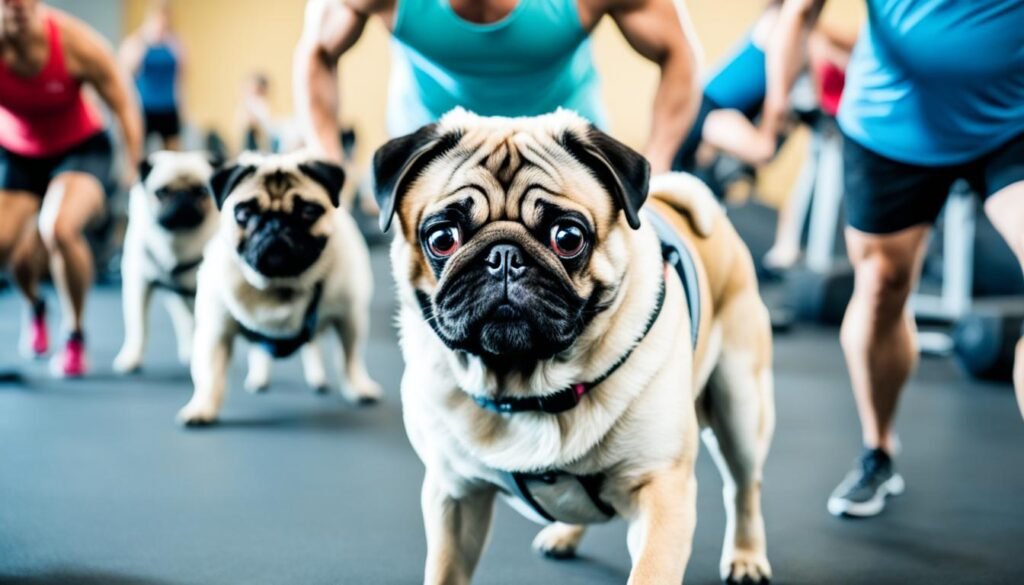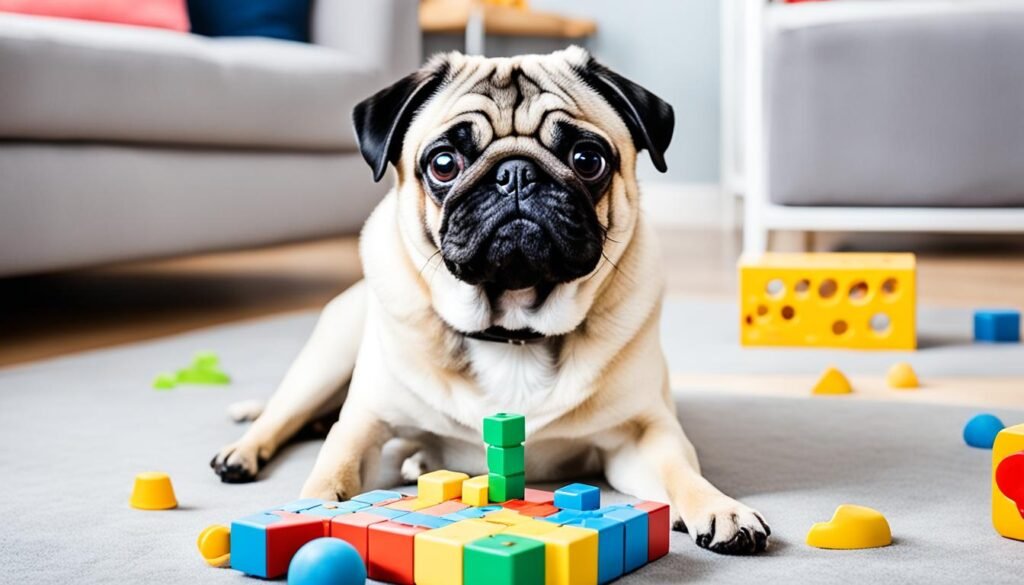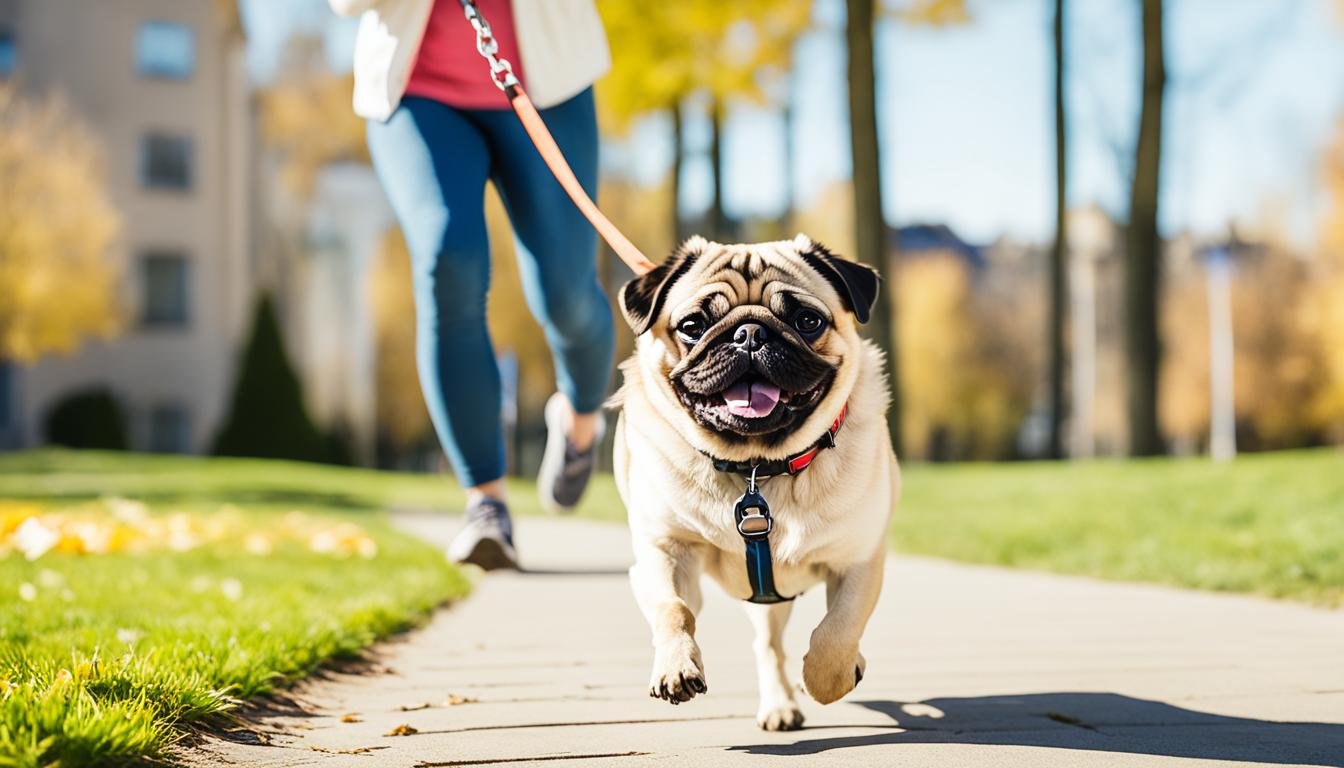The Biggest Mistakes People Make When Exercising Pugs
When it comes to pug exercise, there are some common mistakes that many people make, unintentionally jeopardizing the health and well-being of their furry friends. To ensure your pug stays fit and happy, it’s essential to educate yourself about proper exercise techniques and avoid these pitfalls.
One of the most overlooked aspects of pug health and fitness is neglecting to wipe their wrinkles. Pugs have adorable wrinkles, but these folds can accumulate dirt, moisture, and bacteria, leading to skin infections or irritations. Regularly cleaning and drying their wrinkles will help prevent any potential issues.
Another mistake is using a collar leash instead of a harness. Pugs have a unique body structure, with a vulnerable respiratory system. Collars can put unnecessary pressure on their necks, making it difficult for them to breathe properly. Opting for a harness distributes the pressure more evenly, ensuring a safer and more comfortable walk for your pug.
Over-training is another common error. While it’s important for pugs to stay active, pushing them too hard can lead to exhaustion, muscle strains, or injuries. Remember that pugs are not endurance athletes, and their exercise routine should be tailored to their specific needs and limitations.
Many pug owners also neglect to provide adequate attention and mental stimulation. Pugs are sociable, intelligent dogs that thrive on human interaction and mental challenges. Setting aside dedicated playtime and engaging their minds with puzzles or toys will go a long way in keeping them happy and mentally stimulated.
Allowing pugs to run without a leash is another mistake that can have serious consequences. Despite their small size, pugs have a tendency to wander and may not have the best recall. Keeping them on a leash during walks or in open spaces ensures their safety and prevents them from running off into potentially dangerous situations.
Hydration is crucial for pugs, yet many owners fail to provide adequate water during exercise. Due to their short snouts, pugs are at a higher risk of heat stroke, making hydration even more critical. Always carry water and offer frequent water breaks to keep your pug properly hydrated.
Last but not least, neglecting grooming and maintenance can have a negative impact on your pug’s health. Regularly brushing their coat, cleaning their ears, and trimming their nails are essential tasks that shouldn’t be overlooked. It not only keeps them looking their best but also helps prevent infections and discomfort.
By understanding and avoiding these common mistakes, you can ensure that your pug enjoys a healthy and enjoyable exercise routine. Take the time to educate yourself on proper pug exercise tips and prioritize your furry friend’s well-being and fitness.
Neglecting to Wipe Pug’s Wrinkles
One of the biggest mistakes pug owners make when it comes to pug care is neglecting to clean their pug’s wrinkles on a regular basis. Pugs are known for their adorable wrinkled faces, but those wrinkles require proper attention and maintenance to keep them healthy and free from infections.
Pug wrinkles have a tendency to collect dirt, debris, and moisture, creating the perfect breeding ground for germs and bacteria. If not cleaned regularly, these wrinkles can become a hotbed for infections, leading to discomfort and potential health issues for your furry friend.
To prevent pug wrinkle infections, it’s crucial to incorporate regular pug wrinkle cleaning into your grooming routine. This involves gently wiping the wrinkles with a clean, damp cloth or a specially formulated pug wrinkle cleaning solution. You should pay particular attention to the folds and crevices, ensuring that you remove any trapped dirt or moisture.
By making pug wrinkle cleaning a priority, you can effectively prevent pug wrinkle infections and promote your pug’s overall health and well-being. Regular cleaning will help to keep your pug’s skin clean and free from harmful bacteria, reducing the risk of skin irritations and uncomfortable infections.
Remember, pug care extends beyond regular grooming and exercise. It’s essential to pay attention to the specific needs of your pug’s wrinkles and take proactive measures to keep them clean and healthy. So, don’t forget to give those adorable pug wrinkles the care they deserve!

Using Collar Leash Instead of Harness
When it comes to taking your pug for a walk, it’s crucial to prioritize their safety and well-being. Unfortunately, many pug owners make the mistake of using a collar leash instead of a harness. While a collar leash may seem like a convenient option, it can actually pose several risks to your furry friend.
Pugs have a unique body structure that makes pressure on their necks from a leash problematic and can cause breathing difficulties. The delicate features and short snouts of pugs make them more susceptible to respiratory issues, making it important to take extra precautions during walks. Using a harness instead of a collar leash is recommended to ensure the safety and comfort of your pug.
A harness distributes the pressure from the leash across your pug’s chest and shoulders, reducing strain on their neck and throat. This helps to prevent any potential harm or discomfort while allowing for better control during walks. Additionally, harnesses are available in various sizes and styles, providing a comfortable fit for your pug.
When considering pug leash options, it’s essential to understand the benefits of a harness versus a collar. While collars may be suitable for some dog breeds, they are not ideal for pugs. By opting for a harness, you can alleviate any potential risks and promote a safer and more enjoyable walking experience for both you and your pug.
Pug Walking Precautions
When walking your pug, it’s important to keep a few precautions in mind:
- Always use a harness instead of a collar leash to prevent strain on their neck.
- Ensure the harness fits snugly but comfortably and does not restrict their movement.
- Regularly check the harness for any signs of wear and tear, and replace it if necessary.
- Use a leash that is suitable for your pug’s size and strength.
- Practice loose leash walking techniques to minimize pulling and promote a relaxed walk.
- Be mindful of environmental factors such as extreme temperatures and walking surfaces that might cause discomfort or injury to your pug.
By following these pug walking precautions and choosing the right leash option, you can ensure that your pug enjoys their walks safely and comfortably, while also strengthening the bond between you and your furry companion.
Over-Training Pugs
When it comes to pug fitness routines, finding the right balance is key. While it’s important to ensure your pug gets enough exercise, it’s equally vital to be aware of their exercise limitations. Over-training pugs can have negative consequences on their health and well-being.
Pugs are known for their small size and bulkier bodies, which means they may require more effort to run and exercise compared to other dogs. However, this doesn’t mean they can engage in excessive activity without repercussions.
Excessive activity in pugs can lead to exhaustion, overheating, and potential injuries. Pugs are prone to respiratory issues due to their short snouts, and over-training can put further strain on their respiratory system.
It’s important to incorporate pug exercise limitations into their fitness routines. Make sure to provide regular exercise sessions but be mindful of their comfort and well-being. Take breaks and allow them to rest if they show signs of fatigue or overheating.
Understanding Pug Fitness Routines
When designing pug fitness routines, consider low-impact exercises that are suitable for their body type. Walking, swimming, and interactive play sessions are excellent choices for keeping your pug active without overexerting them.
Additionally, mental stimulation is just as important as physical exercise for pugs. Engage them in puzzle toys, obedience training, or interactive games to keep their minds sharp and satisfied.

Your pug’s well-being should always be a top priority. By understanding their exercise limitations and incorporating suitable pug fitness routines into their daily lives, you can help them maintain a healthy and happy lifestyle.
Next, we will explore the importance of providing attention and mental stimulation to pugs, ensuring their overall well-being and happiness.
Neglecting Attention and Mental Stimulation
Pugs are social and affectionate dogs that thrive on human interaction. Neglecting their need for attention and mental stimulation can lead to behavioral issues and overall unhappiness. It is crucial to prioritize spending quality time with your pug to ensure their well-being.
One way to provide mental stimulation for your pug is through obedience training. Pug obedience training for exercise not only enhances their physical fitness but also engages their minds. Teaching them basic commands and tricks can keep them mentally sharp and prevent boredom.
In addition to obedience training, there are various activities that can fulfill your pug’s need for mental stimulation. Puzzles and interactive toys can challenge their problem-solving skills and keep them entertained. Consider hiding treats around the house or using food-dispensing toys to provide mental stimulation while they work for their rewards.
Furthermore, engaging in interactive playtime is essential for pug behavioral needs. Playing fetch, hide-and-seek, or tug-of-war helps stimulate their minds and keep them physically active. Regular exercise and mental stimulation can also prevent destructive behaviors that may arise from boredom or frustration.

Allowing Pugs to Run Without Leash
When it comes to Pug safety precautions, one common mistake many owners make is allowing their Pugs to run without a leash. Pugs are known for their wanderlust and curious nature. They have a tendency to follow their instincts and explore their surroundings, often without realizing the distance from home.
However, allowing Pugs to roam freely can put them in potential danger, especially near busy streets or in unfamiliar areas. Without proper control and supervision, your Pug may easily get lost or get involved in accidents. It’s essential to keep them on a leash at all times.
Pug leash training plays a vital role in ensuring their safety and preventing them from running off. By using a leash, you can have better control over their movements, guide them away from potential hazards, and keep them by your side. It also helps in preventing unwanted interactions with other dogs or people.
Choosing the right leash and harness is crucial for Pugs. Opting for a harness instead of a collar leash can help distribute the pressure evenly across their body, reducing the risk of injury or neck strain. A harness provides better control and prevents pulling or choking, ensuring a more enjoyable walking experience for both you and your furry companion.
Remember, even if your Pug has a secure and well-fenced yard, it’s still important to use a leash when going on walks or venturing into public spaces. Pugs may have a strong wanderlust and could easily be tempted to explore beyond their confines. Avoid risking their safety and always keep them on a leash.
Inadequate Hydration for Pugs
Inadequate hydration for pugs can have serious consequences, especially when it comes to their well-being during outdoor activities and exercise. Pugs have specific hydration needs that owners should be aware of in order to prevent overheating and ensure their pugs’ overall health and comfort.
Proper hydration is essential to prevent pug overheating. Pugs are prone to overheating due to their shortened snouts, which can make it difficult for them to regulate their body temperature. When pugs overheat, it can lead to heat exhaustion and even heat stroke, which can be life-threatening. To prevent this, ensure that your pug has access to fresh water at all times, both indoors and outdoors.
When exercising your pug, always bring a portable water bowl and offer them water regularly, especially during hot weather or intense physical activities. This will help them stay hydrated and cool down their body temperature.
Make it a habit to monitor your pug for signs of overheating such as excessive panting, difficulty breathing, rapid heartbeat, drooling, and pale or blue gums. If you notice any of these signs, it’s crucial to take immediate action to prevent further heat-related complications.
Remember, prevention is the key to keeping your pug healthy and safe. By prioritizing adequate hydration, you can help prevent overheating and its associated risks. Taking proper care of your pug’s hydration needs will go a long way in ensuring their well-being and allowing them to enjoy outdoor activities and exercise without unnecessary risks.
Neglecting Grooming and Maintenance
Pugs are adorable and low-maintenance companions, but that doesn’t mean they can go without proper grooming and maintenance. Neglecting these essential tasks can result in problems like excessive shedding and unpleasant odors. To keep your pug healthy and comfortable, it’s important to follow a few key grooming tips.
Firstly, regular brushing is crucial to control shedding. Pugs have a double coat that sheds year-round, so brush them at least once a week to remove loose fur and minimize the amount of hair you find around your home. This not only keeps your pug looking neat but also helps prevent matting and tangling.
In addition to brushing, don’t forget to clean your pug’s adorable wrinkles. These charming facial folds are prone to collecting dirt, moisture, and debris, which can lead to skin infections. Gently wipe the wrinkles with a damp cloth or use a veterinarian-approved wrinkle cleaner to avoid any irritation. Regularly cleaning your pug’s wrinkles helps prevent unpleasant smells and keeps their skin healthy.
Lastly, maintaining a clean environment is essential for both you and your pug. Regularly washing your pug’s bedding and toys helps eliminate dirt, allergens, and any unpleasant odors. Additionally, keeping your pug’s living area clean and free from debris helps prevent any potential health issues.
Remember, consistent grooming and maintenance lead to a happy and healthy pug. By following these simple tips like regular brushing, cleaning the wrinkles, and maintaining cleanliness, you can keep your pug looking and feeling their best.

